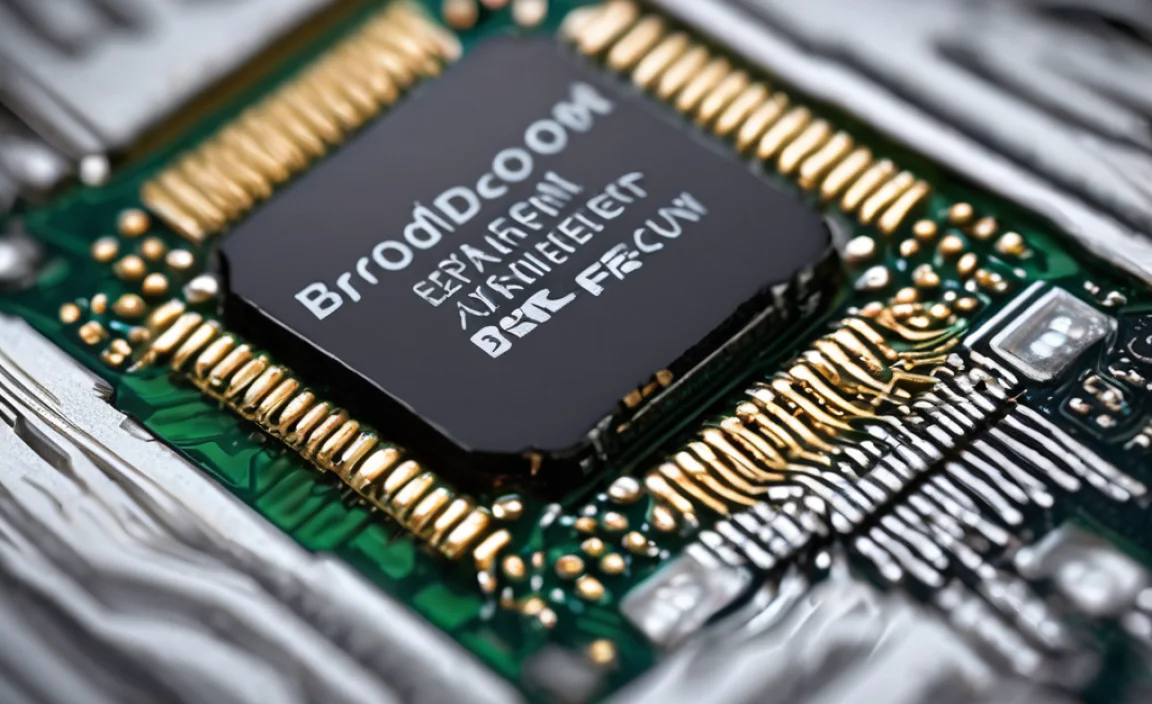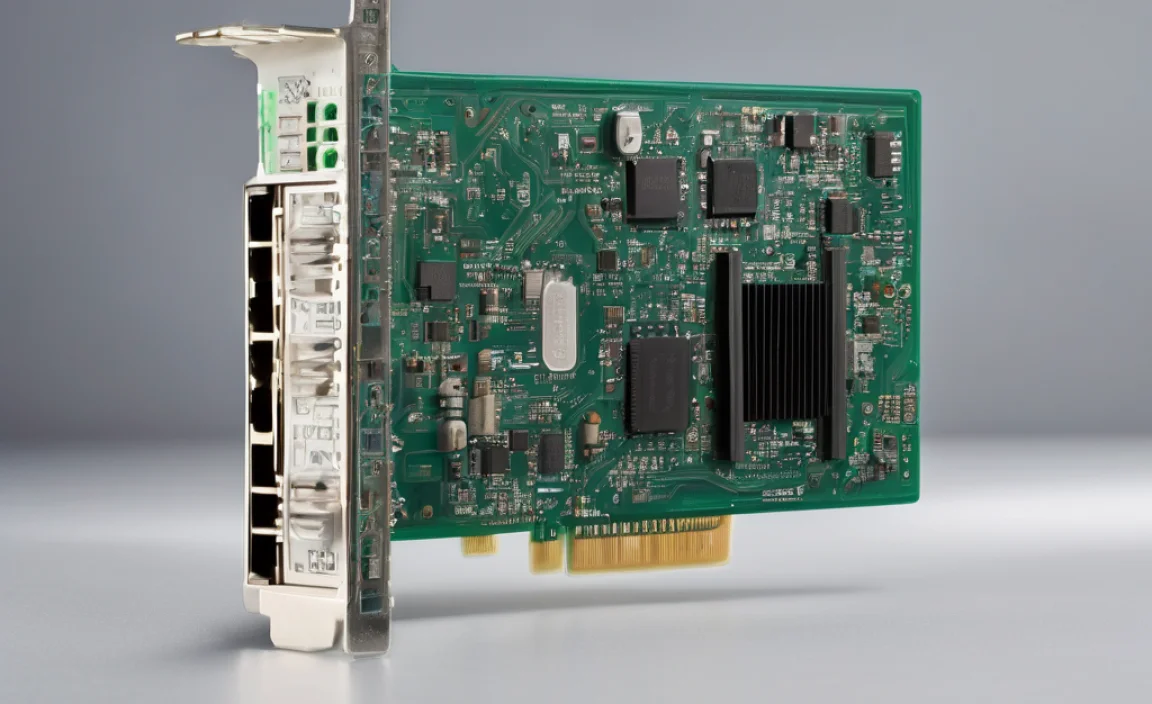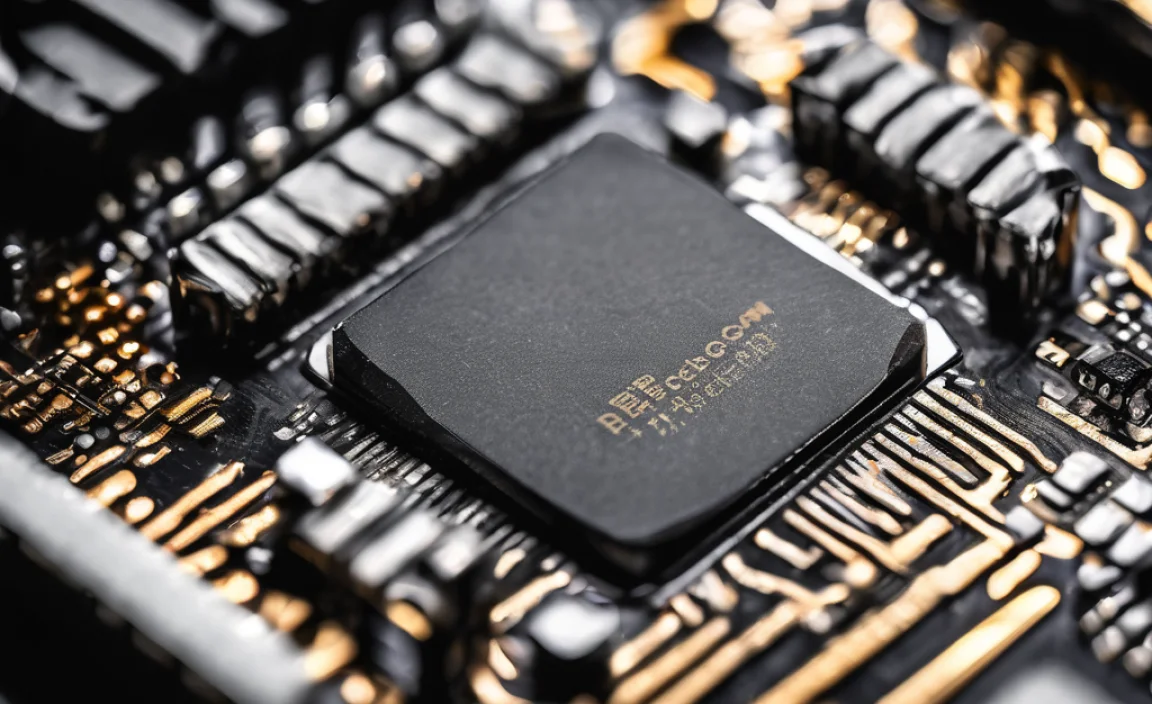Broadcom Ethernet Driver Fix: Get Your Network Back Online Fast!
Is your Broadcom Ethernet adapter not working? Don’t worry! This guide shows you simple, proven ways to fix missing Broadcom Ethernet drivers, getting your Windows computer connected again without the stress.
Having your computer lose its internet connection can be a real bummer. When it’s a Broadcom Ethernet adapter that’s gone quiet, it often means a missing or outdated driver. This can leave you feeling stranded, especially if you need to get online for work, school, or just to chat with friends. But don’t sweat it! We’ll walk through straightforward steps to solve this common problem. You’ll be back online before you know it.
Why Your Broadcom Ethernet Driver Might Be Acting Up

Think of drivers as tiny translators for your computer. They tell your operating system, like Windows, how to talk to specific hardware, such as your Ethernet card. When that translator is missing, outdated, or corrupted, your computer won’t know how to use the Ethernet connection properly. This can happen after a Windows update, a system crash, or even if you’ve recently reinstalled Windows. The good news is, it’s usually a fixable issue.
Understanding Your Broadcom Ethernet Adapter

Before we dive into fixing things, it’s helpful to know a little about your adapter. Broadcom makes many different Ethernet chips that go into laptops and desktop motherboards. This means there isn’t just one “Broadcom Ethernet driver” for everyone. The good news is, identifying which one you need is part of our troubleshooting journey.
Step 1: Identifying Your Specific Broadcom Ethernet Hardware

The first step in any fix is knowing what you’re dealing with. We need to find out the exact model of your Broadcom Ethernet hardware.
Using Device Manager to Find Your Hardware ID
Device Manager is your best friend here. It lists all the hardware connected to your PC and its status.
- Press the Windows key + R on your keyboard. This opens the Run dialog box.
- Type
devmgmt.mscand press Enter or click OK. This opens Device Manager. - In the Device Manager window, look for “Network adapters.” Click the arrow next to it to expand the list.
- You should see your Broadcom Ethernet adapter listed. It might have “Broadcom” in its name. If it has a yellow exclamation mark or a red X, it means there’s a problem.
- Right-click on the Broadcom Ethernet adapter.
- Select “Properties” from the menu.
- Go to the “Details” tab.
- In the “Property” dropdown menu, select “Hardware Ids.”
- You’ll see a list of codes. The first one (VEN_xxxx&DEV_yyyy) is the most important. This tells us the Manufacturer (VEN) and the Device (DEV) IDs for your specific Broadcom chip. Copy these IDs; you’ll need them later.
This Hardware ID is like a fingerprint for your network card.
Step 2: Finding the Right Broadcom Ethernet Driver

Now that you have your Hardware IDs, it’s time to find the correct driver. This is where we need to be a bit careful to avoid downloading the wrong software.
Option A: Using the Manufacturer’s Support Website (Recommended for Stability)
This is the safest and most reliable way to get drivers.
- For Laptops: Go to the support website of your laptop manufacturer (e.g., Dell, HP, Lenovo, Acer). Enter your laptop’s Service Tag or model number. Look for the “Drivers & Software” or “Support” section. Search for “Ethernet” or “LAN” drivers for your specific operating system (e.g., Windows 7).
- For Desktops (Motherboard): If your Ethernet is part of your motherboard, go to the motherboard manufacturer’s website (e.g., ASUS, Gigabyte, MSI, ASRock). Find the support page for your motherboard model and download the latest LAN/Ethernet drivers for your OS.
- Broadcom’s Website: While Broadcom used to have a direct driver download portal, they often direct users back to the hardware manufacturer (like your PC or motherboard maker). However, sometimes you can find drivers by searching their site using the Hardware IDs you copied. A good place to start is often by searching Broadcom’s support pages. You might need to navigate to their networking solutions section.
When searching, pay close attention to the operating system version (like Windows 7 32-bit or 64-bit) and whether it’s for a laptop or desktop.
Option B: Using a Trusted Driver Update Tool (For Convenience)
If finding drivers on manufacturer sites is proving difficult, a reputable driver update tool can help. These tools scan your system and identify missing or outdated drivers, then help you download and install them.
It’s crucial to use a well-known and trusted tool. Some popular and generally reliable options include:
- Driver Booster
- Snappy Driver Installer Origin (SDIO)
These tools often work by using large databases of drivers, and some, like SDIO, can even download driver packs for offline installation, which is perfect for a computer not connected to the internet.
Note: Be cautious of generic driver download sites. Stick to official manufacturers or highly recommended tools to avoid malware.
Step 3: Installing the Broadcom Ethernet Driver

Once you’ve downloaded the driver file, it’s time to install it.
Manual Installation from a Downloaded File
This is the most common method if you downloaded a driver installer (.exe file).
- Locate the driver file you downloaded. It’s usually in your Downloads folder.
- Double-click the installer file to run it.
- Follow the on-screen instructions. This usually involves agreeing to terms and conditions and clicking “Next” or “Install.”
- The installer will copy the necessary files to your computer.
- Once the installation is complete, it’s highly recommended to restart your computer. This ensures the new driver is loaded correctly.
Installing Without an Installer File (Using Device Manager)
Sometimes, you might download a ZIP file containing driver files (.inf, .sys, .cat).
- Right-click the downloaded driver file (if it’s a ZIP, first extract its contents to a folder).
- Go back to Device Manager (as in Step 1).
- Right-click your Broadcom Ethernet Adapter.
- Select “Update driver.”
- Choose “Browse my computer for driver software.”
- Click “Browse…” and navigate to the folder where you extracted the driver files. Ensure “Include subfolders” is checked.
- Click “Next.” Windows will search for compatible drivers in that folder and install the best match.
- You might see a security warning; if you trust the source of the driver, click “Install this driver software anyway.”
- Restart your computer after installation.
Step 4: Verifying the Driver Installation
After you’ve installed the driver and restarted your PC, we need to check if it worked.
- Open Device Manager again (Windows Key + R, type
devmgmt.msc, press Enter). - Expand “Network adapters.”
- Your Broadcom Ethernet adapter should now be listed without any error icons (yellow exclamation marks or red Xs).
- You can also check your network status by right-clicking the network icon in your system tray (usually near the clock) and selecting “Open Network and Sharing Center” or “Network & Internet settings,” depending on your Windows version. You should see your Ethernet connection listed as active.
If everything looks good, congratulations! Your Broadcom Ethernet adapter should now be working.
Troubleshooting Common Issues & Error Codes
Even with the right steps, some issues can pop up. Here are a few common ones.
Broadcom Ethernet Missing Driver for Windows 7 Offline Installer
This is a frequent scenario. If you’re on Windows 7 and need to install drivers without an internet connection, the best approach is to download the driver files on another working computer using the methods mentioned in Step 2. Then, transfer these files to your Windows 7 machine using a USB drive. You can then use the “Install Without an Installer File” method (Step 3, Option B) if you have the raw driver files, or run the .exe installer if you downloaded one. For Windows 7 specifically, finding older drivers can sometimes be tricky, so checking the exact motherboard or laptop manufacturer’s archive sections is key.
Error Code 10
This error in Device Manager often means the device cannot start. It could be a driver issue or a hardware conflict. Reinstalling the driver from scratch, as outlined above, is the first step. If that doesn’t work, you might try uninstalling the device completely from Device Manager (right-click and select “Uninstall device”), then rebooting your PC. Windows will try to detect the hardware again and prompt for a driver.
Error Code 43
This is a more general error, often indicating that Windows has stopped the device because it reported problems. Again, a clean driver reinstallation is the primary solution. Ensure you are downloading the correct driver version for your exact hardware and Windows version.
Error Code 31
This means the driver is installed, but Windows cannot start the device. It’s similar to Code 10 and often suggests a driver conflict or corruption.
How to Find Drivers for Older Operating Systems Like Windows 7
Many users still rely on Windows 7, and finding drivers for it can be more challenging as manufacturers phase out support.
Here’s how to approach it:
- Manufacturer Websites (Primary Source): Even for older models, laptop and motherboard manufacturers usually keep driver archives on their support pages. Look for sections like “Legacy Support” or “Previous Versions.”
- Broadcom’s Driver Support: While Broadcom often points to OEM sites, you might find older drivers by searching their driver archives. Use your Hardware IDs here.
- Third-Party Driver Archives: Websites that specialize in maintaining old drivers exist. However, you must be extremely cautious. Stick to reputable sites known for clean driver downloads. Some sites may bundle drivers with software, so always scan downloads with antivirus software.
- Windows Update Catalog: Sometimes, Microsoft itself might have older drivers available through its Update Catalog. You can search this catalog using your Hardware IDs. Visit the Microsoft Update Catalog.
Remember, installing drivers for older OS versions like Windows 7 requires extra care to ensure compatibility and security. Always prioritize official sources.
Table: Driver Installation Methods Compared
Here’s a quick look at different ways to install drivers and their pros and cons.
| Method | Pros | Cons |
|---|---|---|
| Manufacturer’s Website | Most reliable and safe, specifically tailored. | Can be time-consuming to find the exact driver. |
| Trusted Driver Update Tool | Fast and convenient, scans all drivers. | Requires trust in the tool, potential for unwanted software with free versions. |
| Device Manager (Manual Install) | Good for specific driver files (.inf), more control. | Requires identifying driver files first, can be complex for beginners. |
Step 5: Keeping Your Drivers Updated
Once your Ethernet driver is working, you don’t want it to stop again! Keeping drivers updated is a good practice for system stability and security.
Why Update Drivers?
- Bug Fixes: Developers release updates to fix known issues and improve performance.
- Security: Updates can patch vulnerabilities that could be exploited.
- New Features: Sometimes drivers come with optimizations or new capabilities.
- Compatibility: Ensures your hardware works seamlessly with the latest Windows updates.
How to Keep Drivers Updated
- Windows Update: Windows Update often pushes driver updates automatically. Check “Optional updates” for driver releases.
- Manufacturer Support Tools: Many PC and component manufacturers provide their own update utilities (e.g., Dell Update, HP Support Assistant, Lenovo Vantage). These are usually safe and convenient.
- Revisit Manufacturer Websites: Periodically check the support pages for your PC or motherboard for new driver versions.
- Driver Update Tools: If you prefer using a driver update tool, keep it updated and run scans regularly.
Regular maintenance means fewer surprises!
Conclusion
Dealing with a missing Broadcom Ethernet driver might seem daunting, but by following these steps, you can confidently resolve the issue. We’ve covered how to identify your hardware, find the right driver, install it correctly, and even troubleshoot common errors. Remember, your computer hardware relies on these drivers to communicate properly. Keeping them updated ensures your system runs smoothly and securely. You’ve got this! Take a deep breath, follow the guide, and get back online.
Frequently Asked Questions (FAQ)
Q1: My computer doesn’t detect the Broadcom Ethernet adapter at all. What should I do?
If the adapter isn’t showing up in Device Manager at all, it could be a hardware issue, or it might be disabled in your system’s BIOS/UEFI settings. First, try enabling it in the BIOS (you usually access BIOS by pressing Del, F2, or F10 during startup). If it’s enabled there, and still not visible, it’s possible there’s a hardware problem with the card itself or its connection.
Q2: Can I install drivers for Windows 7 onto Windows 10?
No, you generally cannot. Drivers are specific to the operating system version they were designed for. A Windows 7 driver will not work correctly, and could potentially cause further issues, on Windows 10. Always download drivers that precisely match your operating system.
Q3: I downloaded a driver, but it’s a .zip file. How do I install it?
First, you need to extract the files from the .zip archive. Right-click the .zip file and select “Extract All…” or “Unzip.” Choose a folder to save the extracted files. Once unzipped, you can proceed with installing them, often by running a setup.exe file or by using Device Manager’s “Browse my computer for driver software” option pointing to the folder with the extracted .inf file.
Q4: What is a Hardware ID, and why is it important?
A Hardware ID is a unique code that identifies your specific piece of hardware to Windows. It consists of a Vendor ID (VEN) and a Device ID (DEV). Knowing these IDs is crucial because it allows you to search for the exact driver that matches your network adapter, preventing compatibility issues or the installation of incorrect, potentially harmful, drivers.
Q5: I’m trying to find a Broadcom Ethernet driver for Windows 7 offline installer. Where is the best place to look?
For an offline installer on Windows 7, your best bet is to first identify your exact Broadcom hardware using Device Manager. Then, visit the support website of your laptop or motherboard manufacturer. They often provide driver archives for older operating systems like Windows 7. If not found there, carefully search Broadcom’s legacy driver sections or use a trusted driver pack tool designed for offline use.
Q6: Will installing drivers from a third-party driver website be safe?
It can be risky. While some third-party sites are reputable and curate clean drivers, many are not. They might bundle drivers with unwanted software, adware, or even malware. It’s always safest to get drivers directly from the hardware manufacturer (your PC maker, motherboard maker) or Broadcom’s official site. If you must use a third-party site, ensure it’s highly recommended and always scan downloaded files with reliable antivirus software.
